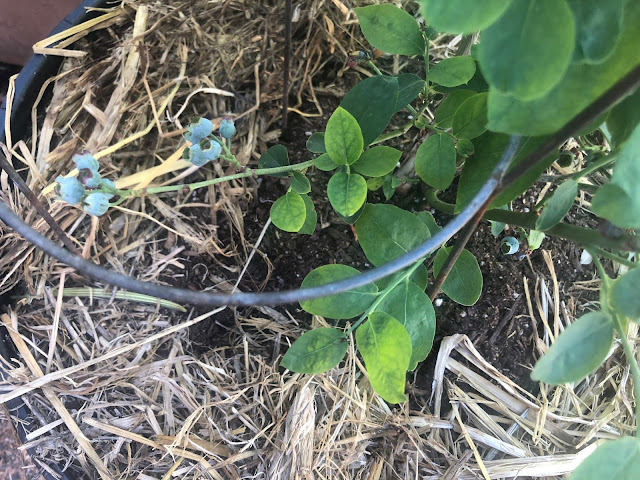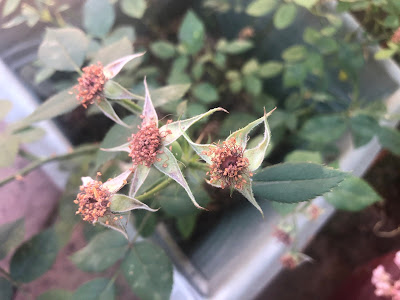
A morning inspection can catch growing problems

|
|
This Misty blueberry got some more straw mulch. The ring is from an old
tomato cage that supports a piece of shade cloth over the potted plant. (Photos:
Kathy Morrison)
|
Early morning in May, time for Garden Patrol. Accompanied by four-legged Garden Supervisor Elsie T. Katt, I do a quick walk through my front and back gardens, making mental notes on what's happened to plants overnight. Already checked the weather report — it's going to be 91 today, down a bit from yesterday's 97, but still plenty warm.
Here's my morning checklist, generally by priority:
Wilting. In the morning, this is not a good sign. Many plants will temporarily wilt in the afternoon during high heat -- tomatoes and squash among them -- but recover overnight. Does the plant need water? If it was just watered yesterday, maybe it needs to be moved, or it's rootbound and needs a larger pot. Could this plant use (more) mulch? Maybe some shade cloth?
Drooping. Different from wilting, to me this means a heavy branch or a spindly seedling that needs thinning or some support now before it breaks.
Distorted or chewed leaves. Hmm, could be aphids or caterpillars. If the leaves didn't look like this yesterday, I can act fast and might be able to prevent a full-on pest attack. Water-spray prescribed for aphid removal, but check first for evidence of lady beetles or other aphid-eaters at work. If close inspection turns up evidence of "caterpillar poop," a light dusting of Bt ( bacillus thuringiensis ) might be in order.
Seedlings. Check to see if any sprouts are up where I've put in seeds -- basil, zinnias and sunflowers this week -- and also whether they're too close together, need a light spritz or maybe a few more seeds should be added. Are the sprouts noticed yesterday still doing OK? Have the birds discovered them? If so, time for some berry basket covers.
Yellow leaves. There are so many reasons for yellowing leaves: underwatering, overwatering, lack of nitrogen, insect attacks, various wilts, sunburn, and on and on. If there are one or two yellow leaves on an otherwise healthy, established plant, I put it on my mental "watch" list. But if it's a recently planted specimen, or the color change is dramatic, the plant goes straight to triage. By the way, this Plant Problem Diagnostic Tool from UC Integrated Pest Management is a terrific help in figuring out what's wrong.

|
| The Crazy Dottie rose could use some clean-up. |
OK, crucial things dealt with, it's time for a coffee break. Ms. Katt and I will be back outside again later.
May is such an important time in the garden. Here's a post I wrote last May that is relevant still: "Mistakes Gardeners are Making Now They'll Pay for Later This Summer."
Comments
0 comments have been posted.Sacramento Digs Gardening to your inbox.
Food in My Back Yard Series
April 22: Should you stock up on fertilizer? (Yes!)
April 15: Grow culinary herbs in containers
April 8: When to plant summer vegetables
April 1: Don't be fooled by these garden myths
March 25: Fertilizer tips: How to 'feed' your vegetables for healthy growth
March 18: Time to give vegetable seedlings some more space
March 11: Ways to win the fight against weeds
March 4: Potatoes from the garden
Feb. 25: Plant a fruit tree now -- for later
Feb. 18: How to squeeze more food into less space
Feb. 11: When to plant? Consider staggering your transplants
Feb. 4: Starting in seed starting
Sites We Like
Garden Checklist for week of April 27
Once the clouds clear, get to work. Spring growth is in high gear.
* Set out tomato, pepper and eggplant transplants.
* From seed, plant beans, beets, cantaloupes, carrots, corn, cucumbers, melons, pumpkins, radishes and squash. Plant onion sets.
* In the flower garden, plant seeds for asters, cosmos, celosia, marigolds, salvia, sunflowers and zinnias. Transplant petunias, zinnias, geraniums and other summer bloomers.
* Plant perennials and dahlia tubers for summer bloom. Late April is about the last chance to plant summer bulbs, such as gladiolus and tuberous begonias.
* Transplant lettuce and cabbage seedlings.
* Weed, weed, weed! Don’t let unwanted plants go to seed.
* April is the last chance to plant citrus trees such as dwarf orange, lemon and kumquat. These trees also look good in landscaping and provide fresh fruit in winter.
* Feed citrus trees with a low dose of balanced fertilizer (such as 10-10-10) during bloom to help set fruit. Keep an eye out for ants.
* Apply slow-release fertilizer to the lawn.
* Thoroughly clean debris from the bottom of outdoor ponds or fountains.
* Start thinning fruit that's formed on apple and stone fruit trees -- you'll get larger fruit at harvest (and avoid limb breakage) if some is thinned now. The UC recommendation is to thin fruit when it is about 3/4 of an inch in diameter. Peaches and nectarines should be thinned to about 6 inches apart; smaller fruit such as plums and pluots can be about 4 inches apart. Apricots can be left at 3 inches apart. Apples and pears should be thinned to one fruit per cluster of flowers, 6 to 8 inches apart.
* Azaleas and camellias looking a little yellow? If leaves are turning yellow between the veins, give them a boost with chelated iron.
* Trim dead flowers but not leaves from spring-flowering bulbs such as daffodils and tulips. Those leaves gather energy to create next year's flowers. Also, give the bulbs a fertilizer boost after bloom.
* Pinch chrysanthemums back to 12 inches for fall flowers. Cut old stems to the ground.
* Mulch around plants to conserve moisture and control weeds.